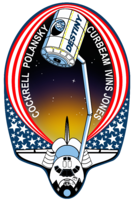STS-98
 | |
| Dane misji | |
| Indeks COSPAR | 2001-006A |
|---|---|
| Zaangażowani | |
| Oznaczenie kodowe | STS-98 |
| Pojazd | |
| Wahadłowiec | Atlantis |
| Załoga | |
 W białych kombinezonach, od lewej: Robert Curbeam i Thomas Jones, z przodu od lewej: Mark Polansky, Marsha Ivins i Kenneth Cockrell | |
| Dowódca | Kenneth Cockrell |
| Start | |
| Miejsce startu | Stany Zjednoczone, KSC, LC39-A |
| Początek misji | 7 lutego 2001 23:13:02 UTC[1] |
| Orbita okołoziemska | |
| Apogeum | 378 km |
| Perygeum | 365 km |
| Okres orbitalny | 92 min |
| Inklinacja orbity | 51,5° |
| Lądowanie | |
| Miejsce lądowania | Edwards Air Force Base, Kalifornia, pas startowy 22 |
| Lądowanie | 20 lutego 2001 20:33:05 UTC[1] |
| Czas trwania misji | 12 dni, 21 godzin, 20 minut i 3 sekundy[1] |
| Przebyta odległość | 8,5 mln km[2] |
| Liczba okrążeń Ziemi | 202[2] |
| Program lotów wahadłowców | |
STS-98 – misja wahadłowca Atlantis agencji NASA do Międzynarodowej Stacji Kosmicznej (ISS). Był to dwudziesty trzeci lot promu kosmicznego Atlantis i sto drugi programu lotów wahadłowców[3].
Cel misji
Siódmy lot wahadłowca na stację orbitalną ISS – dołączenie do stacji amerykańskiego modułu laboratoryjnego Destiny[3].
Załoga
- Kenneth Cockrell (4)*, dowódca (CDR)
- Mark L. Polansky (1), pilot (PLT)
- Robert L. Curbeam (2), specjalista misji (MS1)
- Marsha S. Ivins (5), specjalista misji (MS2)
- Thomas Jones (4), specjalista misji (MS3)
- *(w nawiasie podano liczbę lotów odbytych przez każdego z astronautów)
Parametry misji
- Masa:
- startowa orbitera: 115 529 kg
- lądującego orbitera: 90 225 kg
- ładunku: 14 515 kg
- Perygeum: 365 km[4]
- Apogeum: 378 km[4]
- Inklinacja: 51,5°[4]
- Okres orbitalny: 92 min[4]
Dokowanie do ISS
- Połączenie z ISS: 9 lutego 2001, 16:51:00 UTC
- Odłączenie od ISS: 16 lutego 2001, 14:05:50 UTC
- Łączny czas dokowania: 6 dni 21 godzin 14 minut 50 sekund
Spacer kosmiczny
- EVA-1 (10 lutego 2001, 7 godz. 34 min): T. Jones, R. Curbeam.
- EVA-2 (12 lutego 2001, 6 godz. 50 min): T. Jones, R. Curbeam.
- EVA-3 (14 lutego 2001, 5 godz. 25 min): T. Jones, R. Curbeam.
Zobacz też
Przypisy
- ↑ a b c d Spaceflight mission report: STS-98 (ang.). Spacefacts. [dostęp 2017-07-27].
- ↑ a b podsumowanie misji STS-98 na stronie KSC (ang.)
- ↑ a b c Tomáš Přibyl: Dzień, w którym nie wróciła COLUMBIA. Bielsko-Biała: Wydawnictwo >DEBIT<, 2003, s. 174. ISBN 83-7167-224-1.
- ↑ a b c d STS 98 (ang.). W: NSSDCA Master Catalog [on-line]. NASA. [dostęp 2014-06-20]. [zarchiwizowane z tego adresu (2016-03-08)].
Linki zewnętrzne
- podsumowanie misji STS-98 na stronie KSC (ang.)
- Mark Wade: STS-98 (ang.). W: Encyclopedia Astronautica [on-line]. [dostęp 2017-07-27].
- Spaceflight mission report: STS-98 (ang.). Spacefacts. [dostęp 2017-07-27].
Media użyte na tej stronie
The flag of Navassa Island is simply the United States flag. It does not have a "local" flag or "unofficial" flag; it is an uninhabited island. The version with a profile view was based on Flags of the World and as a fictional design has no status warranting a place on any Wiki. It was made up by a random person with no connection to the island, it has never flown on the island, and it has never received any sort of recognition or validation by any authority. The person quoted on that page has no authority to bestow a flag, "unofficial" or otherwise, on the island.
This is the insignia for STS-98, which marks a major milestone in assembly of the International Space Station (ISS). Atlantis' crew will deliver the United States Laboratory, Destiny, to the ISS. Destiny will be the centerpiece of the ISS, a weightless laboratory where expedition crews will perform unprecedented research in the life sciences, materials sciences, Earth sciences, and microgravity sciences. The laboratory is also the nerve center of the Station, performing guidance, control, power distribution, and life support functions. With Destiny's arrival, the Station will begin to fulfill its promise of returning the benefits of space research to Earth's citizens. The crew patch depicts the Space Shuttle with Destiny held high above the payload bay just before its attachment to the ISS. Red and white stripes, with a deep blue field of white stars, border the Shuttle and Destiny to symbolize the continuing contribution of the United States to the ISS. The constellation Hercules, seen just below Destiny, captures the Shuttle and Station's team efforts in bringing the promise of orbital scientific research to life. The reflection of Earth in Destiny's window emphasizes the connection between space exploration and life on Earth.
These five astronauts have been in training for the STS-98 mission, scheduled for launch aboard the Space Shuttle Atlantis in January of 2001. The crew is composed of astronauts Kenneth D. Cockrell (right front), mission commander; and Mark L. Polansky (left front), pilot; along with astronauts Marsha S. Ivins, Robert L. Curbeam, Jr., (left rear) and Thomas D. Jones (right rear), all mission specialists. Curbeam and Jones are the scheduled extravehicular activity (EVA) participants for the International Space Station's 5A mission.
Autor: Patrick McCracken, Licencja: CC BY-SA 3.0
Shuttle Launch at Sunset (Atlantis, February 7th, 2001, STS-98). The sun has set just behind the camera, so only the upper part of the plume is in the glare of the sun. It casts a shadow through the Earth's atmosphere that seems to stretch towards the moon, which is nearly full and thus almost exactly opposite the sun in the sky.
The Earth's shadow is also visible, as a dark band of sky below the Moon.








